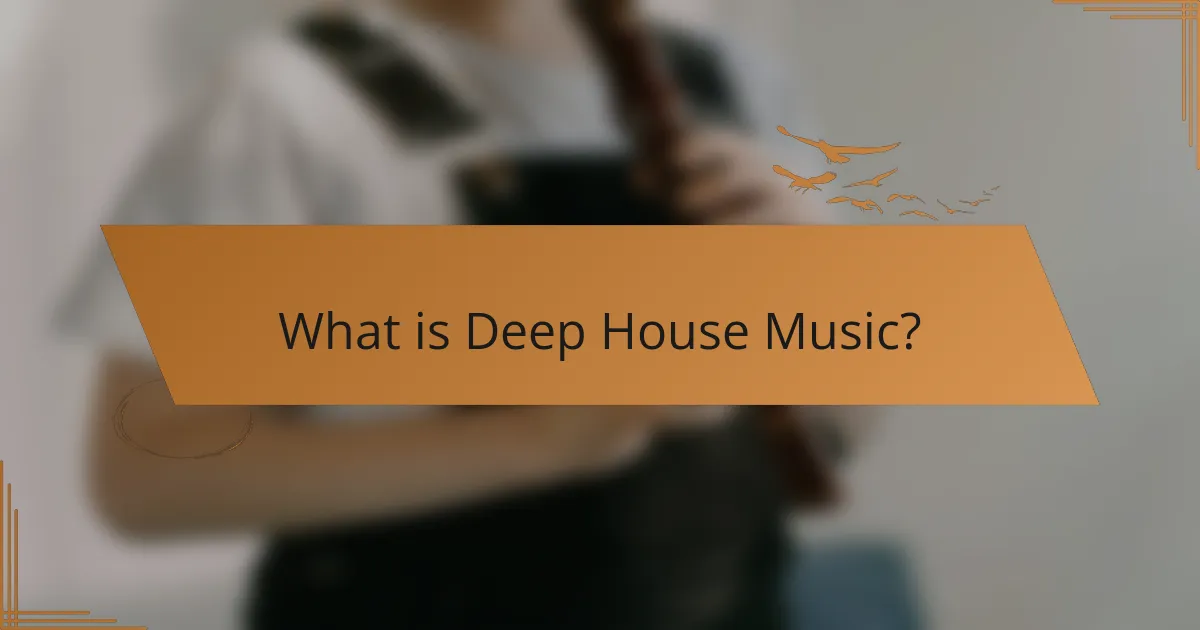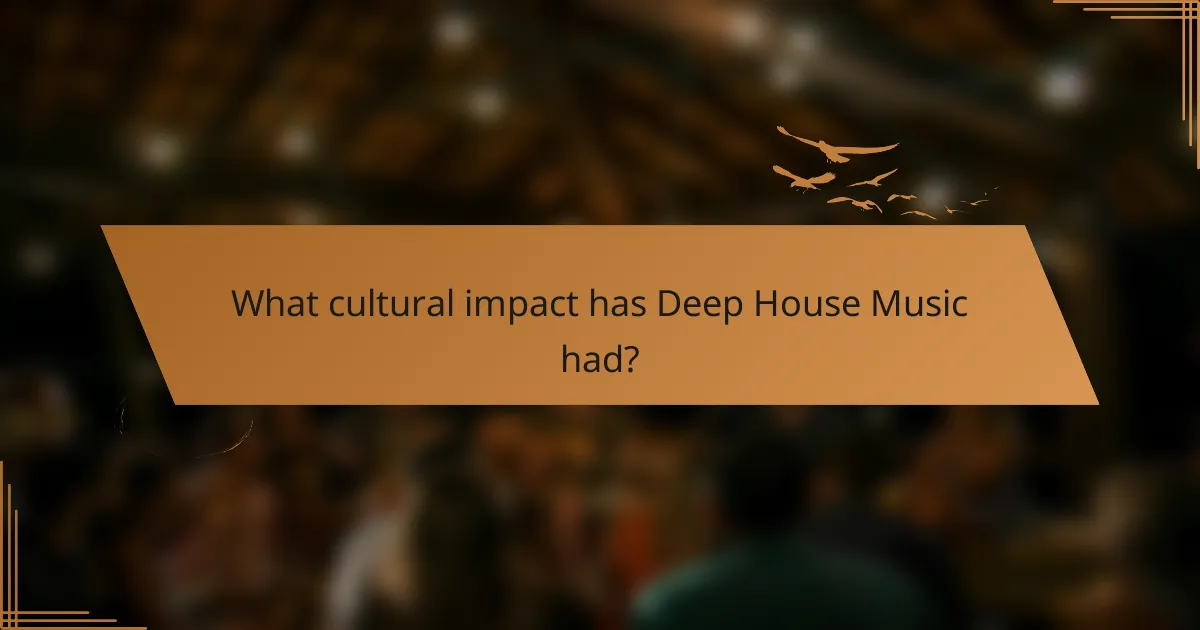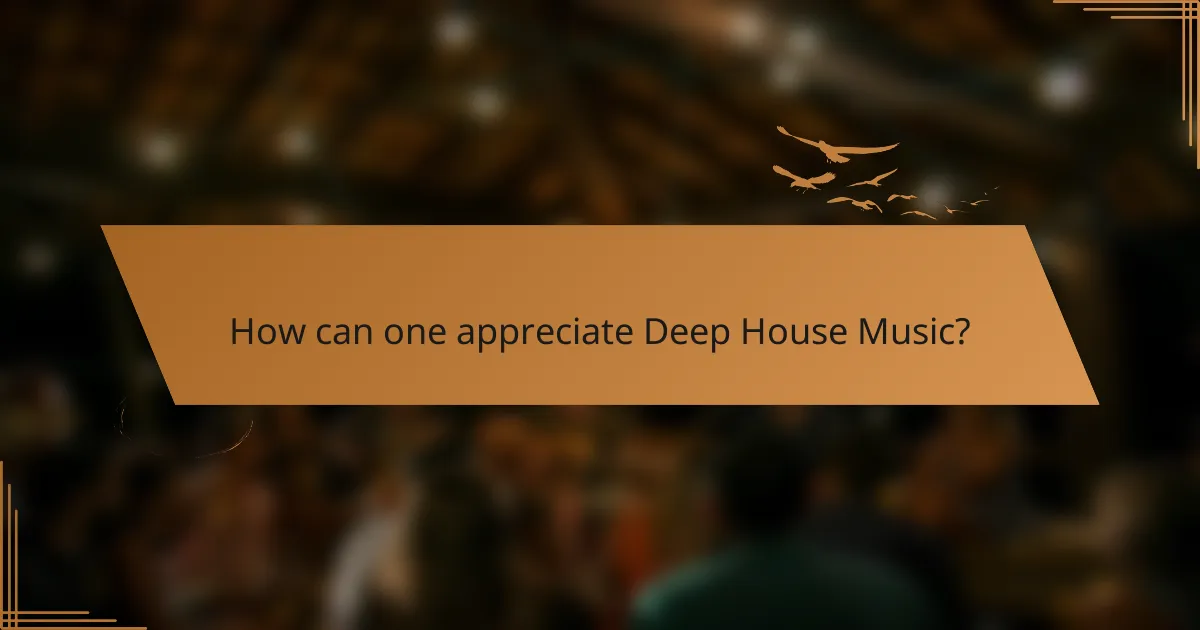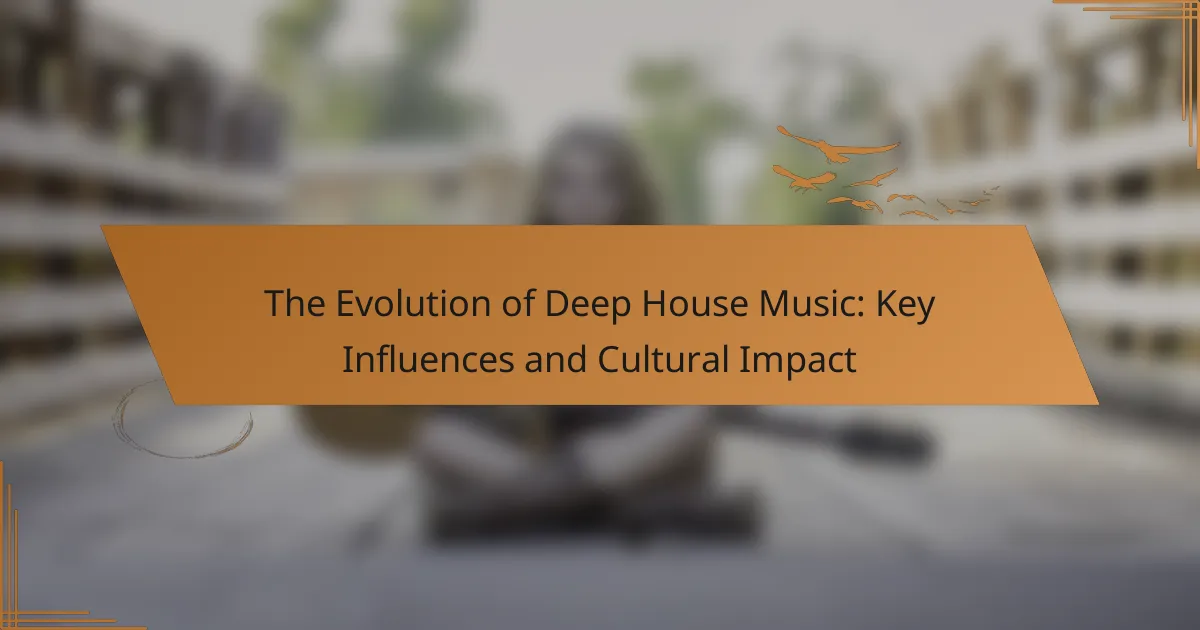Deep house music is a subgenre of house music known for its complex melodies, soulful vocals, and slower tempo, typically ranging from 120 to 125 beats per minute. Originating in the 1980s, deep house incorporates elements of jazz, soul, and funk, and has significantly influenced global music culture and social movements. The genre gained popularity in the 1990s with the rise of electronic dance music (EDM) and has fostered inclusivity in nightlife and festivals. Key artists like Larry Heard and Frankie Knuckles played pivotal roles in its development. The article explores the evolution of deep house music, its cultural impact, and the ways it has contributed to community building and social cohesion in urban areas.

What is Deep House Music?
Deep house music is a subgenre of house music characterized by its use of complex melodies, soulful vocals, and a slower tempo. It typically features a tempo range of 120 to 125 beats per minute. Deep house incorporates elements from jazz, soul, and funk, creating a rich, atmospheric sound. The genre emerged in the 1980s, influenced by artists like Larry Heard and Frankie Knuckles. It gained popularity in the 1990s with the rise of electronic dance music culture. Deep house music often emphasizes emotional and introspective themes in its lyrics. Its production techniques include the use of synthesizers and sampled instruments. The genre continues to evolve, influencing various music styles and artists today.
How did Deep House Music originate?
Deep House Music originated in the 1980s in Chicago. It emerged as a subgenre of house music, blending elements of jazz, soul, and funk. Pioneering DJs like Frankie Knuckles and Larry Heard played a significant role in its development. They incorporated smooth melodies and deeper basslines into the music. The genre gained popularity in underground clubs and raves. Its distinct sound emphasized emotional and atmospheric qualities. By the late 1980s, Deep House began to spread to other cities, influencing global music scenes. This evolution established it as a key genre in electronic dance music.
What are the key characteristics of Deep House Music?
Deep House Music is characterized by its smooth, soulful sound and deep basslines. It typically features a tempo ranging from 120 to 125 BPM. The genre incorporates elements of jazz, funk, and soul, creating a rich auditory experience. Vocals in Deep House are often soft and melodic, enhancing the emotional depth. The use of synthesizers and electronic instruments is prevalent, contributing to its distinctive sound. Additionally, atmospheric pads and ambient effects are common, adding layers of texture. The genre emerged in the 1980s, influenced by Chicago house music. Its evolution has led to a diverse range of sub-genres and styles within the Deep House category.
How does Deep House differ from other electronic music genres?
Deep House is characterized by its smooth, soulful sound and slower tempo, typically ranging from 120 to 125 BPM. Unlike other electronic genres, it incorporates elements of jazz, funk, and soul music. Deep House often features lush, atmospheric synths and deep basslines, creating an immersive listening experience. Vocals in Deep House are frequently soft and melodic, contrasting with the more aggressive styles of genres like Techno or Dubstep. The genre emphasizes groove and rhythm, encouraging a relaxed dance atmosphere. Historically, Deep House emerged in the 1980s, influenced by Chicago house music but distinguished by its melodic and harmonic complexity. This sets it apart from more minimalistic or hard-hitting electronic genres.
What are the main influences on Deep House Music?
Deep House Music is primarily influenced by Chicago house, jazz, funk, and soul music. Chicago house laid the foundation with its repetitive beats and synthesized sounds. Jazz contributes complex harmonies and improvisational elements. Funk adds rhythmic grooves and bass lines that drive the music. Soul music infuses emotional depth and vocal styles. Additionally, the incorporation of electronic music technology has shaped its production techniques. These influences create the unique sound that defines Deep House Music today.
Which artists played a pivotal role in shaping Deep House?
Larry Heard, also known as Mr. Fingers, played a pivotal role in shaping Deep House. He is credited with creating foundational tracks like “Can You Feel It.” His work established the genre’s signature sound characterized by smooth melodies and deep basslines. Another influential artist is Frankie Knuckles, often referred to as the “Godfather of House.” He helped popularize Deep House in the Chicago club scene during the 1980s. Additionally, Kerri Chandler contributed significantly with his unique production techniques and soulful approach. These artists collectively defined the genre’s essence, influencing countless musicians and the broader electronic music landscape.
How did other music genres contribute to the evolution of Deep House?
Deep House evolved significantly through influences from various music genres. The genre incorporated elements from Chicago House, which emphasized soulful vocals and basslines. Detroit Techno contributed a more mechanical sound and innovative production techniques. Disco’s rhythmic grooves and orchestration added a danceable quality to Deep House. Jazz and Funk introduced complex chord progressions and improvisation, enriching its musicality. Additionally, Ambient music influenced the atmospheric textures found in Deep House tracks. These contributions shaped Deep House into a diverse and dynamic genre, appealing to a broad audience.

What cultural impact has Deep House Music had?
Deep House Music has significantly influenced global music culture and social movements. Originating in the 1980s, it blends elements of jazz, soul, and funk. This genre has contributed to the rise of electronic dance music (EDM) culture. Deep House has fostered inclusivity in nightlife and festival settings. It has provided a platform for diverse artists to express their creativity. The genre has also influenced fashion and lifestyle trends. Cities like Chicago and Detroit, where Deep House was born, experienced cultural revitalization due to its popularity. Research indicates that Deep House has played a role in community building and social cohesion in urban areas.
How has Deep House Music influenced social movements?
Deep House Music has influenced social movements by serving as a platform for expression and unity. The genre emerged in the 1980s, rooted in the underground club scene. It often addresses themes of love, community, and social justice. These themes resonate with various social movements, including [censured] rights and anti-racism efforts. The music fosters a sense of belonging among diverse groups. Events like the Chicago House Music Festival highlight its cultural significance. Notably, artists like Frankie Knuckles have used their platforms for activism. The genre’s inclusive nature encourages participation and solidarity in social causes.
In what ways has Deep House Music affected nightlife and club culture?
Deep House Music has significantly influenced nightlife and club culture by creating immersive experiences. Its smooth, soulful sound encourages extended dancing and connection among attendees. This genre promotes a relaxed atmosphere, contrasting with more aggressive electronic styles. Deep House has also shaped club aesthetics, leading to venues focusing on intimate settings and high-quality sound systems. Additionally, it has inspired a vibrant community of DJs and producers who prioritize artistry and emotional expression. Events dedicated to Deep House often feature longer sets, allowing for deeper musical journeys. The genre has contributed to the global club scene, connecting diverse cultures through shared musical experiences.
How does Deep House Music reflect cultural diversity?
Deep House Music reflects cultural diversity through its incorporation of various musical styles and influences. It blends elements from jazz, soul, and funk, showcasing African American roots. The genre often features vocal samples and instrumentation from different cultures. This fusion creates a rich tapestry of sound that appeals to a global audience. Additionally, Deep House music has roots in the Chicago and Detroit scenes, which are historically influenced by immigrant communities. The genre’s evolution has included international artists contributing their unique cultural perspectives. This collective influence highlights the interconnectedness of music across borders. The result is a genre that celebrates diversity while fostering unity among listeners.
What role does Deep House Music play in contemporary music scenes?
Deep House Music plays a significant role in contemporary music scenes by influencing various genres and promoting a distinct cultural aesthetic. This genre blends elements of jazz, soul, and funk with electronic music. It fosters an immersive listening experience characterized by smooth melodies and deep basslines.
Deep House has gained popularity in clubs and festivals worldwide, shaping the sound of modern dance music. Artists like Disclosure and Duke Dumont have helped bring the genre into mainstream consciousness. The genre also encourages collaboration among artists across different musical styles.
Moreover, Deep House serves as a platform for social connection and community building. It creates spaces for diverse audiences to engage with music and dance. Its emotional depth resonates with listeners, making it a staple in contemporary playlists.
The genre’s evolution reflects broader trends in music consumption, including the rise of digital platforms. Streaming services have made Deep House more accessible, increasing its reach and influence. Overall, Deep House Music continues to shape contemporary music scenes through its unique sound and cultural relevance.
How is Deep House Music being integrated into modern music production?
Deep House Music is being integrated into modern music production through the use of its characteristic elements and techniques. Producers incorporate deep basslines, smooth melodies, and vocal samples into various genres. This fusion creates a unique sound that appeals to a broader audience. The genre’s emphasis on atmosphere and groove enhances pop, hip-hop, and electronic music tracks. Collaborations between deep house artists and mainstream musicians have increased its visibility. Additionally, software and plugins designed for deep house sounds are widely available. This accessibility encourages experimentation among producers. The rise of streaming platforms has also facilitated the genre’s integration into playlists and radio shows. Overall, Deep House Music continues to influence and reshape contemporary music production.
What are the current trends in Deep House Music?
Current trends in deep house music include a blend of organic sounds and electronic elements. Artists are increasingly incorporating live instrumentation into their tracks. There is a notable rise in collaborations between deep house producers and vocalists. Additionally, the use of atmospheric sounds and ambient textures is becoming more prevalent.
The genre is also seeing influences from other styles, such as techno and jazz. This cross-genre experimentation is broadening the appeal of deep house music. The emergence of online platforms for music distribution has facilitated the rise of independent artists. Streaming services are also shaping listening habits and trends within the genre.
These trends reflect a dynamic evolution in deep house music, emphasizing creativity and collaboration.

How can one appreciate Deep House Music?
To appreciate Deep House Music, one should listen actively to its intricate rhythms and melodies. Focus on the layered sounds that create its unique atmosphere. Pay attention to the deep basslines and smooth vocals that characterize the genre. Understanding the historical context enhances appreciation, as Deep House evolved from Chicago house music in the 1980s. Engaging with live performances can provide a deeper connection to the music. Exploring various subgenres within Deep House can also broaden one’s understanding. Listening to influential artists like Frankie Knuckles and Larry Heard showcases the genre’s roots. Participating in community events and discussions can deepen appreciation further.
What are some recommended Deep House tracks for beginners?
“Some recommended Deep House tracks for beginners include ‘Can’t Get Enough’ by Soulsearcher, ‘Deep Inside’ by Hardrive, and ‘Finally’ by Kings of Tomorrow. These tracks exemplify the smooth, soulful sound characteristic of Deep House. ‘Can’t Get Enough’ features uplifting vocals and a groovy bassline. ‘Deep Inside’ is known for its iconic vocal sample and deep rhythm. ‘Finally’ showcases emotional lyrics combined with a melodic beat. These tracks are often played in clubs and are staples in Deep House playlists.”
How can listeners identify the unique elements of Deep House Music?
Listeners can identify the unique elements of Deep House Music by recognizing its characteristic sound and structure. Deep House typically features smooth, soulful vocals and complex chord progressions. The tempo usually ranges from 120 to 125 beats per minute. A distinctive use of basslines sets it apart from other electronic genres. The genre often incorporates jazz and funk influences, creating a rich auditory experience. Additionally, Deep House frequently employs atmospheric pads and minimalistic percussion. These elements contribute to its laid-back yet engaging vibe. The genre’s roots can be traced back to the 1980s Chicago house scene, which solidifies its identity.
What tips can enhance the experience of listening to Deep House Music?
To enhance the experience of listening to Deep House Music, consider using high-quality headphones or speakers. Quality audio equipment reproduces the intricate sound layers typical in Deep House. Create a comfortable listening environment with minimal distractions. This allows for better focus on the music’s nuances. Engage in active listening by paying attention to the basslines, melodies, and rhythms. Deep House often features complex arrangements that deserve careful attention. Explore playlists or curated mixes to discover new artists and tracks. This broadens your exposure to the genre’s diversity. Lastly, consider the time of day; listening in the evening can enhance the immersive experience.
How can one create a Deep House playlist for various occasions?
To create a Deep House playlist for various occasions, start by identifying the mood or theme of the event. Select tracks that match the atmosphere, such as upbeat songs for parties or mellow tunes for relaxation. Incorporate a mix of classic and contemporary Deep House tracks to appeal to different tastes. Include tracks with smooth basslines and soulful vocals, which are characteristic of the genre. Ensure a good flow by arranging songs in a way that transitions smoothly from one to another. Pay attention to the duration of the playlist to keep it engaging without becoming repetitive. Utilize platforms like Spotify or SoundCloud for curated playlists and recommendations. According to a study by the University of Southern California, music significantly influences mood and behavior, making the right selection crucial for the occasion.
Deep house music is a subgenre of house music known for its complex melodies, soulful vocals, and slower tempo, typically ranging from 120 to 125 BPM. Originating in the 1980s in Chicago, it blends influences from jazz, soul, and funk, creating a rich and atmospheric sound. The article explores the evolution of deep house music, highlighting its key characteristics, influential artists, and cultural impact, including its role in nightlife, social movements, and contemporary music scenes. Additionally, it discusses current trends, production techniques, and tips for appreciating and creating deep house playlists.
